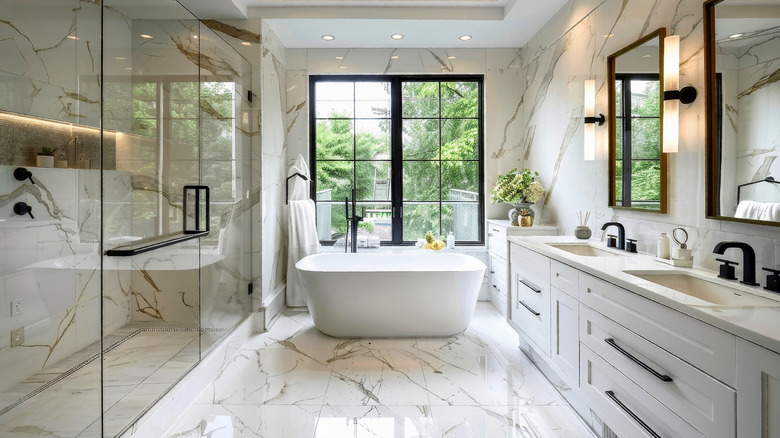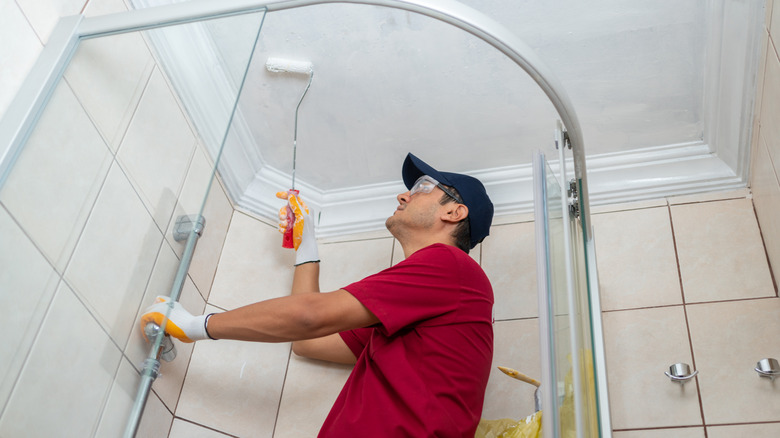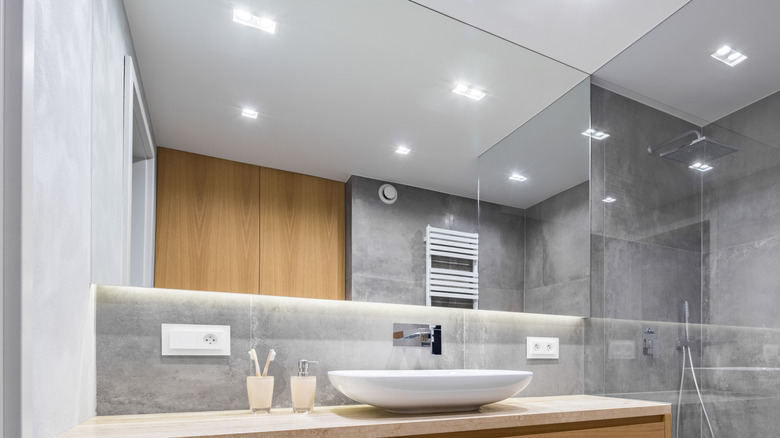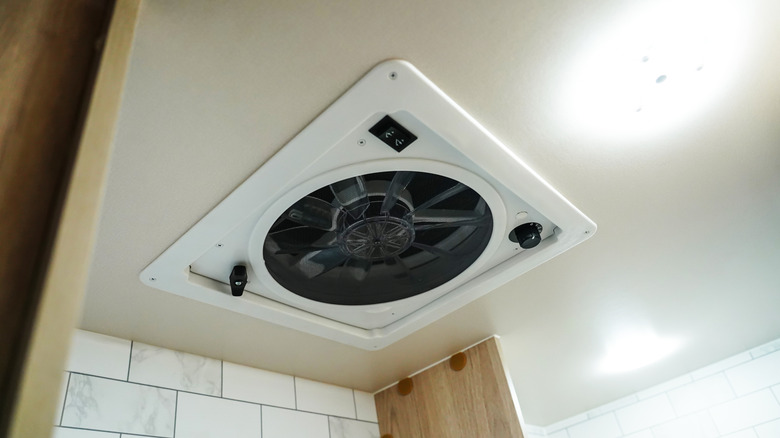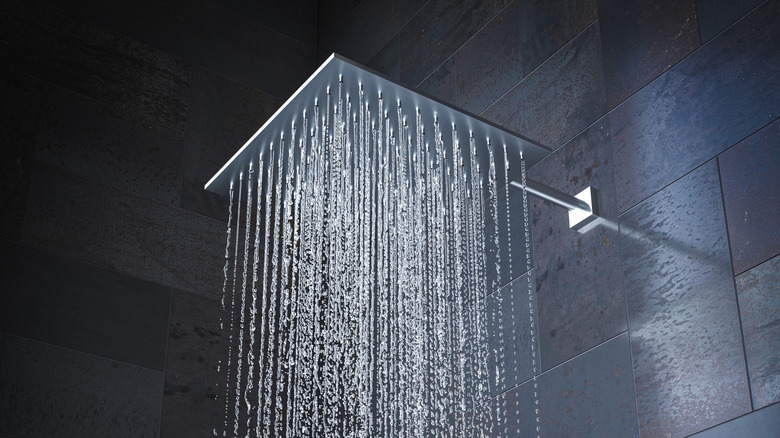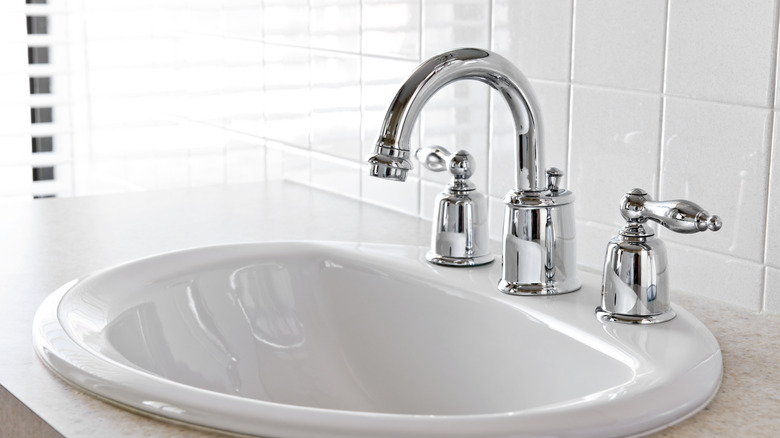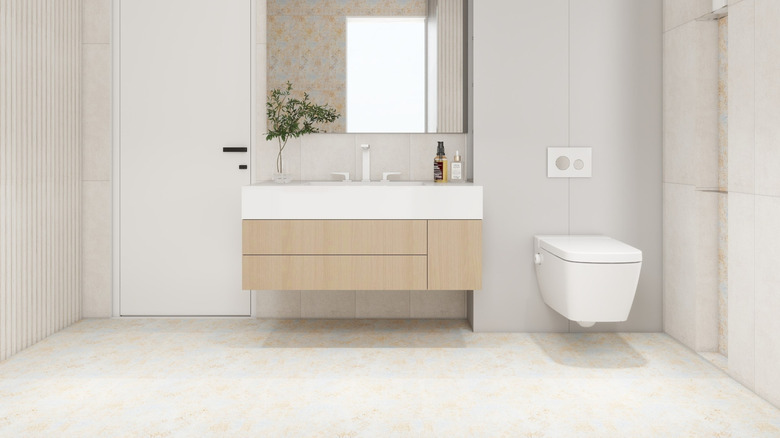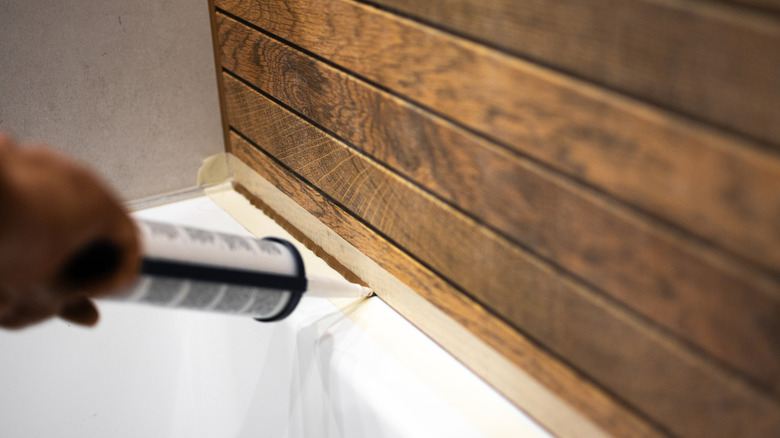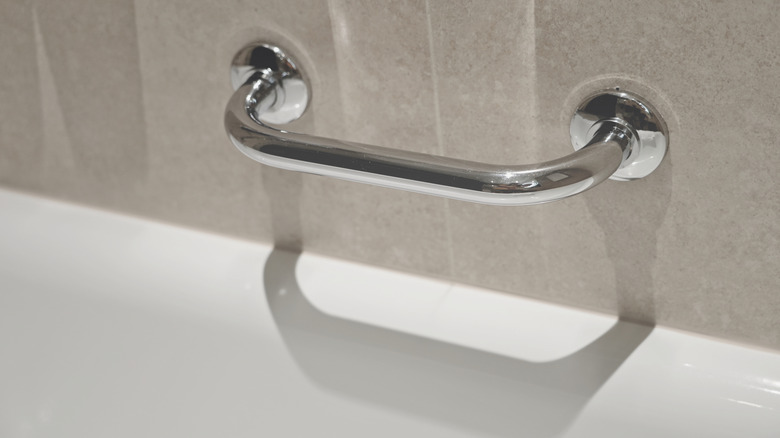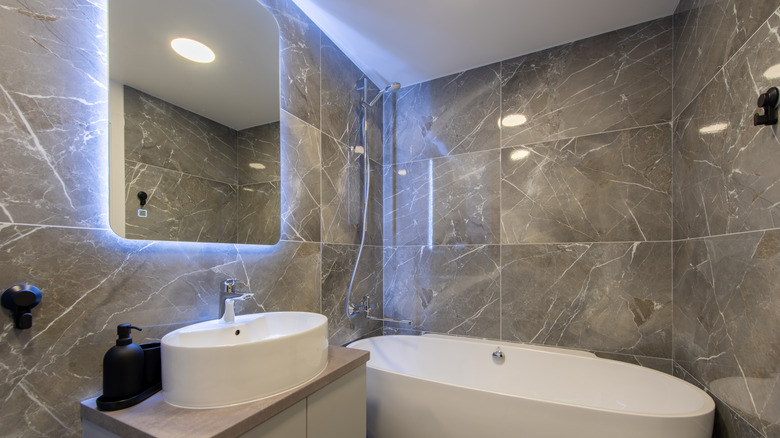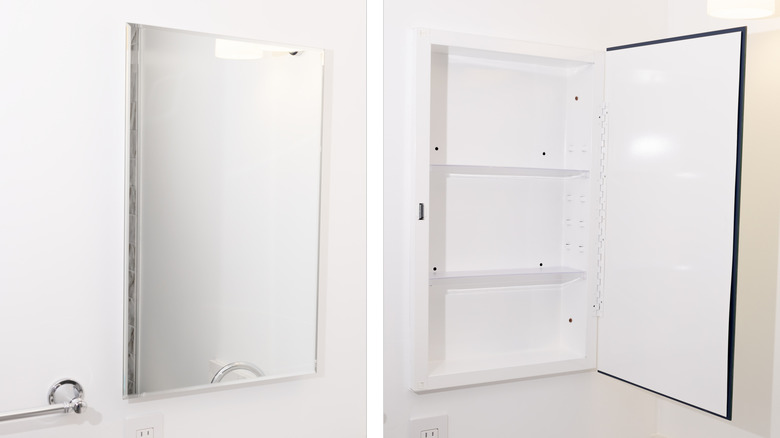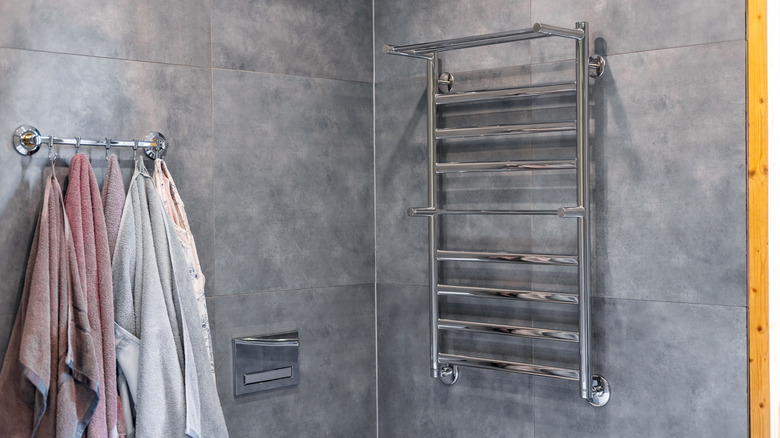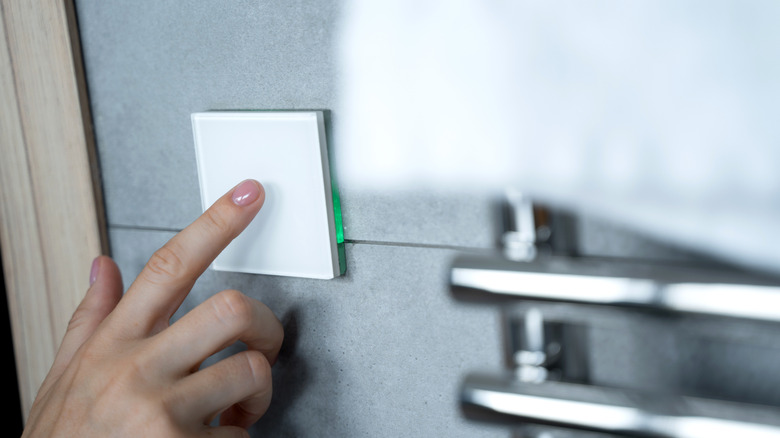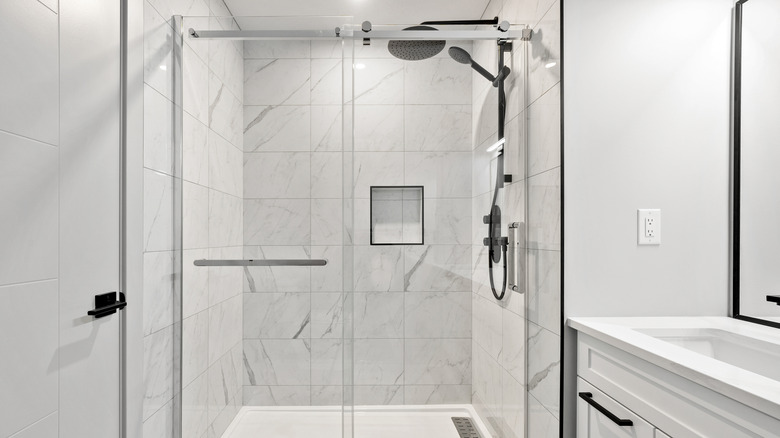13 Bathroom Upgrades That Will Make Your Home More Appealing To Buyers
We may receive a commission on purchases made from links.
Buyers want bathrooms that look clean and modern, run efficiently, and feel bright both in mirror selfies and in person. And, unless your bathroom is in need of significant renovation, you can achieve a modern, updated look with small fixes and bathroom upgrades. A full remodel can cost $17,000 or more. In comparison, things like fresh paint, tight caulk lines, quiet ventilation, and updated fixtures make your home more appealing to buyers without the huge outlay. And, typically, you get around 70% ROI in home value.
Small updates can tell potential buyers that your home has been cared for and won't need costly upgrades right away. Even modest touches, like swapping yellowed switches, adding a framed mirror, or refreshing hardware, show up in listing photos and make a small bathroom feel cleaner and more modern. Refinishing is cheaper and just as effective as renovation when the bathroom's foundation is solid.
Refresh with moisture-resistant paint
Fresh, neutral paint can make a bathroom look bigger and more modern both in photos and in person while also protecting the ceiling from moisture in the future and covering any old stains. Choose satin or semi-gloss for better wipeability and moisture resistance so steam and splashes don't stain or cause peeling or bubbling as easily. Choose a paint specifically formulated for bathrooms, like Diamond Brite kitchen and bathroom paint, for the best, longest-lasting results. If you're concerned about off-gassing, look for a low- or zero-VOC formula limit paint. Stick with light, warm neutrals that bounce light and make small spaces feel bigger. Avoid adding dark, heavy accent walls that can date your bathroom. Patch nail holes, scuff up glossy areas, and clean with a degreaser. Then make sure the space is completely dry before priming and painting to get perfect paint adhesion.
Ventilate well while painting. Run the fan, open a window, and use an exhaust fan if possible. Follow the label precautions, instructions, recoat, and cure times so you don't trap moisture under fresh paint film. You'll also need to look for and treat mold and mildew before you paint. There's no point in just trying to paint over it. Mold is a living organism and will just push right through your new paint if you don't take steps to treat it. First identify the type of mold, then proceed with DIY treatments or call a professional, depending on the severity.
Swap in LED vanity lights and add dimmers
Good light helps buyers see clean tile, true colors, and tidy grout. LED vanity fixtures, like the SineRise LED Modern Bathroom Vanity light fixtures, give bright, even lighting with lower energy use and long life, which buyers appreciate for cost and convenience. Plus, for eco-conscious buyers, having LED lights is a big plus, as it's an easy way to reduce energy use and the home's carbon footprint. Look for warm-to-neutral white (about 2700K–3500K) so skin tones look natural, and aim for fixtures that spread light from both sides of the mirror to reduce shadows under the eyes. If your ceiling light is the only source today, add a dedicated vanity bar or sconces flanking the mirror for better task lighting.
Pair LEDs with a compatible dimmer so you can tune brightness. You want bright light for cleaning and daytime use, and lower for late-night bathroom trips and mellow mornings. Choose fixtures rated for damp locations, and match metal finishes to your faucet and hardware so the room feels cohesive in listing photos. It's also a good idea to replace yellowed glass shades and old bulbs with clear, efficient LEDs for a quick lift while keeping the existing fixture body. You can also add energy-saving controls, like motion sensors and timers.
Upgrade the exhaust fan for quiet, humidity-sensing ventilation
Nothing turns off buyers quite like a musty bathroom. A modern exhaust fan clears fog, reduces odors, and cuts down on mold risk by moving humid air outside. Options like the Panasonic WhisperFit bathroom exhaust fan are engineered to use less energy and often run quieter than older, dated fans, which encourages people to leave them on long enough to dry the room. They're also significantly more efficient at removing moisture. Figure out what type of fan you need. Choose a model sized to your room's square footage, and consider humidity-sensing features so the fan turns on automatically when moisture spikes and off when levels drop sufficiently.
Vent the fan to the exterior, not the attic, to avoid dumping moisture where it can feed mold and damage insulation. Seal the fan housing to drywall with caulk and add an insulated duct if your climate is cold. This helps stop drafts, condensation, and heat loss.
Install a WaterSense showerhead
Buyers care about comfort and costs. A modern WaterSense-labeled showerhead, like the Kingston brass WaterSense high-velocity Aeroflow shower head gives a strong, even spray while using no more than 2 gallons per minute, so you save water and hot-water energy but still get a decent, refreshing, high-pressure shower experience. On average, replacing a conventional showerhead with a WaterSense one saves around 2,700 gallons of water and 330 kilowatt hours of energy per year, which is a significant monetary and environmental saving.
Pick a shower head that matches your shower type, and, if you have low water pressure, look for pressure-compensating designs that keep flow steady across a range of pressures. Use this opportunity to check and possibly replace the O-ring that sits at the point where the head connects to the hose to maximize the upgrade and reduce the potential for extra leaks. Wrap threads with Teflon tape, tighten by hand, and check for leaks. Pair the upgrade with a fresh silicone bead around escutcheons (trim plates) to prevent water seeping behind. If you really want to give your shower a brand-new look, consider adding a sparkling clean glass door to complete your upgrade.
Replace the old faucet (or just the aerator) with a WaterSense model
Swapping a dated faucet instantly lifts the vanity area and the look of the bathtub, and choosing a WaterSense-labeled model also reduces water use without reducing pressure or performance. And, as with a WaterSense showerhead, it boosts your home's energy and water efficiency, cutting costs and carbon footprint. In a typical household, replacing a regular faucet with a WaterSense model saves 700 gallons of water per year, plus reduces water heating energy costs. If a full faucet swap isn't in the cards, a new WaterSense-rated aerator is the cheapest, fastest win.
Match the faucet finish to your lighting, hardware, and mirror frame for a polished, intentional look in photos. While you're there, replace brittle supply lines and add new escutcheons so everything looks fresh. If your vanity is small or has a shallow profile, a single-handle faucet leaves more counter room, and makes the vanity look bigger, as it takes up less space.
Upgrade to a WaterSense, comfort-height toilet
New toilets are a small project with a big payoff. WaterSense-labeled models use no more than 1.28 gallons per flush, which is at least 20% less than the EPA's federal standard and much less than older units buyers may be replacing. The Environmental Protection Agency (EPA) estimate you'll save around 13,000 gallons of water per year, which equates to approximately $140. So the new toilet pays for itself financially and environmentally very quickly.
A modern comfort-height model is also particularly attractive to homebuyers looking at the long term. Over 75% of Americans now want to age in place, meaning that they want to stay in their homes as long as possible. A comfort-height toilet is an aging-friendly addition that those buyers will appreciate. Before you buy, if you're not letting a pro do the job, there are a few things to remember. Firstly, confirm your rough-in (distance between the finished wall and the center of the toilet's floor drain) and whether an elongated or round bowl fits your space. Replace the wax ring, closet bolts, and supply line, too, so the install looks and functions like new. If your bathroom is small, a skirted, compact toilet that hides plumbing looks sleek and contemporary.
Recaulk the tub/shower and regrout where needed
Fresh, straight caulk lines and new grout shows potential buyers that your home is well-maintained and lets them know they won't need to tackle these kinds of basic jobs if they decide to buy. Plus, proper grouting and caulking prevent water damage and reduce the likelihood of mold. So, even if you decide to stay instead of sell, this bathroom upgrade pays off. Moisture that gets behind tiles feeds mold, weakens backer board, and causes musty odors that turn buyers off. Use 100% silicone labeled for bath and tile in corners and change-of-plane joints, and use bathroom-rated grout to fill gaps between tiles. Neutral grout color helps the space look clean and larger.
Cut out failed caulk completely, scrub away soap film, and let the area dry before recaulking so the new bead adheres properly. Follow the package directions to apply a smooth, continuous line of caulk. Be sure to give it the full cure time before you shower again. If grout is cracked or missing, rake out only the damaged sections and regrout, then seal once cured to prevent stains. This is a task you can tackle yourself in a weekend with minimal cost or expertise needed. And, if you find a loose tile, you can re-adhere it while you're grouting.
Add sleek grab bars for age- and mobility-friendliness
Aging in place and living independently is a significant factor in home buying as more Americans want to stay in their homes indefinitely. If you have a house that may appeal to buyers wanting a forever home, adding grab bars that blend into your bathroom design is a smart move that increases your home's accessibility and safety without making it feel like a clinical setting. Contemporary grab bars come in matte black, brushed nickel, and warm metals that match modern fixtures. They add safety for small children, guests, and anyone with limited mobility. Choose textured grips so users' hands do not slip, and place bars where support is most useful, like near the toilet and along the tub or shower wall. Buyers often notice these details because they promise long-term comfort without a remodel.
Mount into studs with stainless fasteners and use bars rated to support at least 250 pounds. Horizontal bars typically sit 33 to 36 inches above the finished floor under the Americans With Disabilities Act accessibility guidelines. For tiled walls without a stud where you need one, use an approved anchoring system rated for grab bars, and follow the manufacturer's instructions. Keep finishes consistent with your faucet and hardware for a cohesive look. In a tiny bathroom, a combined shelf and grab bar gives storage and support in one piece while keeping a clean look.
Replace the builder-grade mirror with a backlit one
A framed or backlit mirror upgrades the look of your bathroom in minutes. Back-lighting reduces harsh shadows and helps small bathrooms feel roomier and contemporary. Tech-forward mirrors with integrated LED lighting and defog functions are popular bathroom upgrades for buyers, as they add a touch of modern luxury. Make sure you choose a product that's rated for moisture exposure/bathroom use. This is a simple project that you can handle yourself unless you get a model that requires hard wiring, in which case you'll need to hire an electrician.
Measure carefully before you buy so the mirror fits the vanity width and does not crowd a sconce or backsplash. If you keep a simple slab mirror, add a clean frame kit in a matching finish for a quick transformation. For backlit designs, use a dedicated, GFCI-protected circuit, which would require an electrician to install. Choose warm to neutral light (about 2700K–3500K) so skin tones look natural for easy, accurate makeup application and personal grooming. Wipe away old adhesive, patch wall scars, and touch up paint so the new mirror sits against a smooth, fresh surface.
Add a recessed medicine cabinet or shelves for storage
Storage is a top bathroom pain point. A recessed medicine cabinet creates hidden space without eating into a tight footprint, which keeps counters clear, making the space look larger and tidier. Buyers also respond well to organized vertical storage that makes a small bathroom feel functional and move-in ready. Consider adding vertical corner shelves if space is super-tight and a wrap-around cupboard like the Kleankin pedestal sink cabinet if you have a pedestal sink.
Choose a mirrored door to double as your vanity mirror or install a narrow unit beside the main mirror for extra capacity. Before you open the wall, call in a plumber and electrician to scan for plumbing and wiring. If recessing is not feasible, add slim floating shelves above the toilet or beside the vanity. The arched wall cabinet from Eyythung is a sleek option. If you don't have the skill or knowledge to start cutting into your walls, be sure to hire a reputable local handyman or carpenter.
Update hardware like pulls, hooks, and towel bars
Hardware really pulls a bathroom's look together. Swapping mismatched pieces for a single, simple modern finish makes a bathroom of any size feel intentional and complete. Matte black, brushed nickel, and warm brass remain timeless choices that pair well with contemporary vanities and tiles. Replace cabinet pulls, towel bars, robe hooks, and toilet paper holders so everything matches the faucet and light fixtures. In tight spaces, choose slimmer profiles and rounded corners for a cleaner look that's safer in close quarters. If you already have two metals you like, repeat them on purpose, using a primary finish for big items and an accent finish for one or two small pieces, so it's an obvious design choice, not a random hodge-podge.
Install towel bars where towels can actually dry; too close to the shower means exposure to steam and, consequently, musty odors. Use secure anchors in drywall if you can't hit studs, and seal fastener holes in wet zones. Match screw heads and escutcheons to the finish so the set looks seamless, and caulk around any place where moisture could penetrate and fester. As a final polish that most people overlook, swap a gunky, worn drain for one that matches the rest of your hardware.
Swap yellowed switches/outlets and add GFCI protection
Yellowed switches and cracked plates make even a clean bath feel dated. Replacing switches and outlet plates with fresh white covers or modern-style rockers cleans up the look instantly, and tamper-resistant outlets are a perk for families and guests with children. In a bathroom, buyers also expect GFCI protection, which rapidly cuts power if a fault is detected and can prevent electrocution. If your bath lacks GFCIs or the "test/reset" buttons don't work, get a pro in to fix that ASAP for your own safety as well as to appeal to buyers.
Choose matching screwless plates for a streamlined look, and keep finishes consistent with the rest of the home so buyers see continuity. If you're adding a backlit mirror or a vent fan timer, you may as well do these upgrades at the same time, especially if you're bringing in an electrician to handle it.
Replace the shower curtain with a sleek glass enclosure
Clear glass opens sightlines, shows off tile, and instantly elevates a dated tub/shower combo. It also photographs better than a curtain, which can look bulky or hide other updated shower features. Tempered safety glass is the standard for shower doors. It shatters into small pieces rather than sharp shards if it breaks. Choose frameless or semi-frameless hardware for a clean, modern edge. In tight spaces, a sliding door saves space while keeping water in.
Measure twice and check wall plumb (the vertical alignment of your wall) so panels sit square and seals work. If your tile is old and tired but you don't want to replace it, give it a deep clean and follow our previous tip to regrout your bathroom tile before installing glass so the enclosure and surround look and feel fresh. Consider low-iron glass for truer color and an easy-clean coating to reduce spotting. These are luxury touches that typically cost only 10 to 15% more than standard glass. Seal hardware penetrations appropriately, and maintain a slight, even pitch on thresholds so water runs in, not out.
